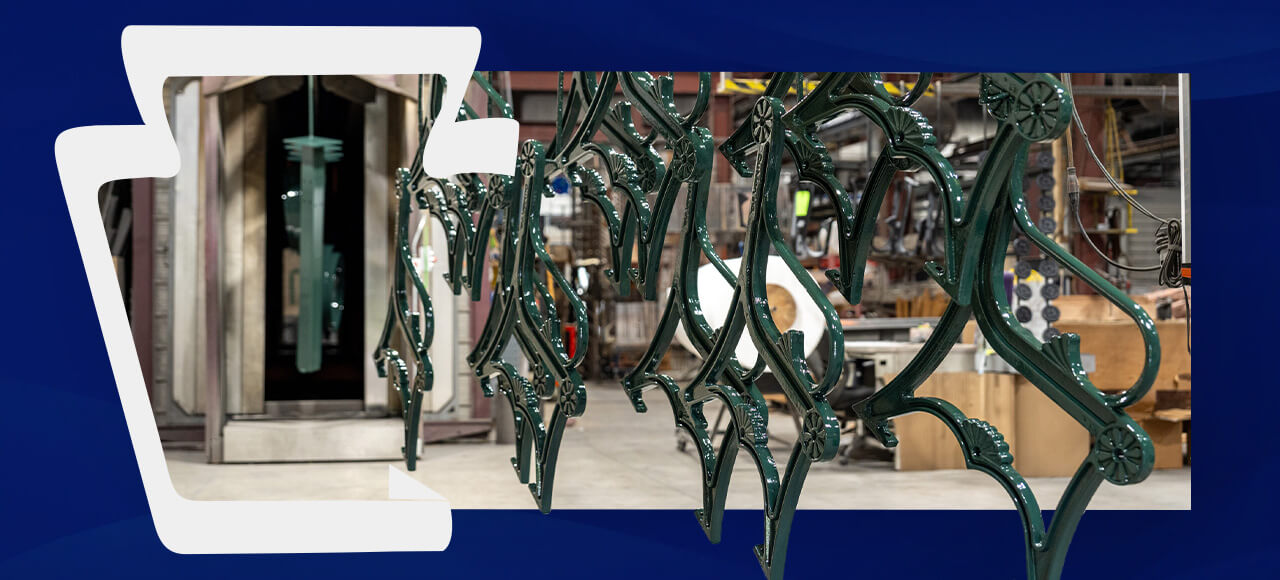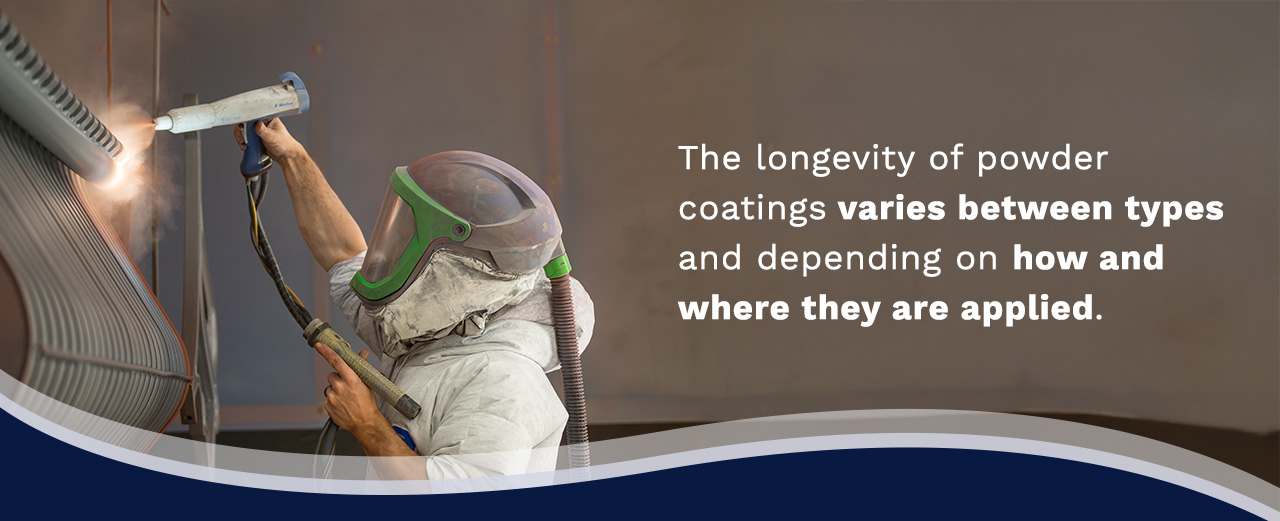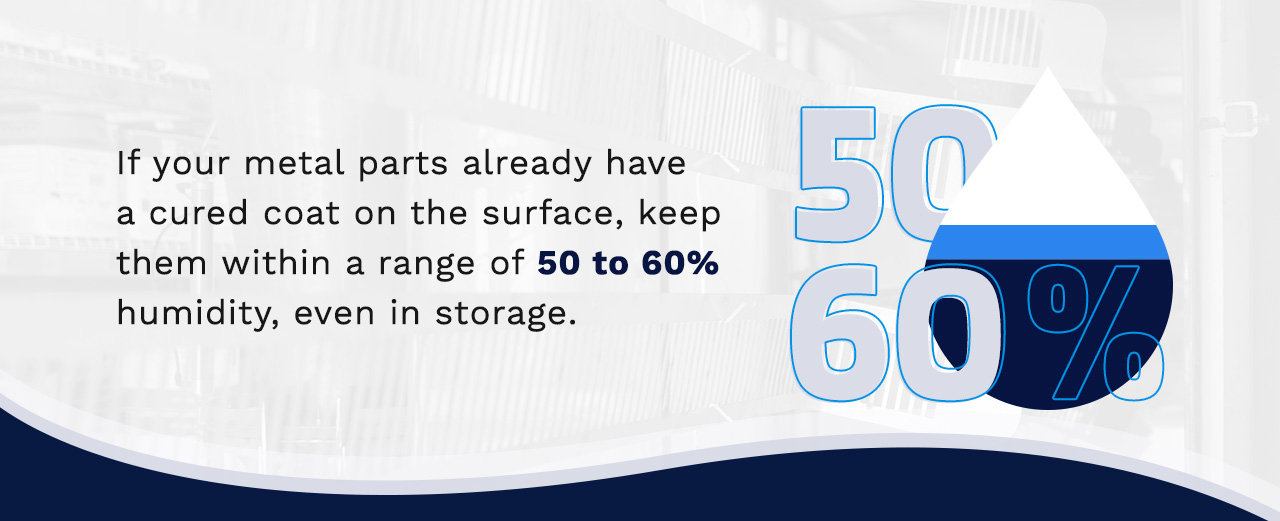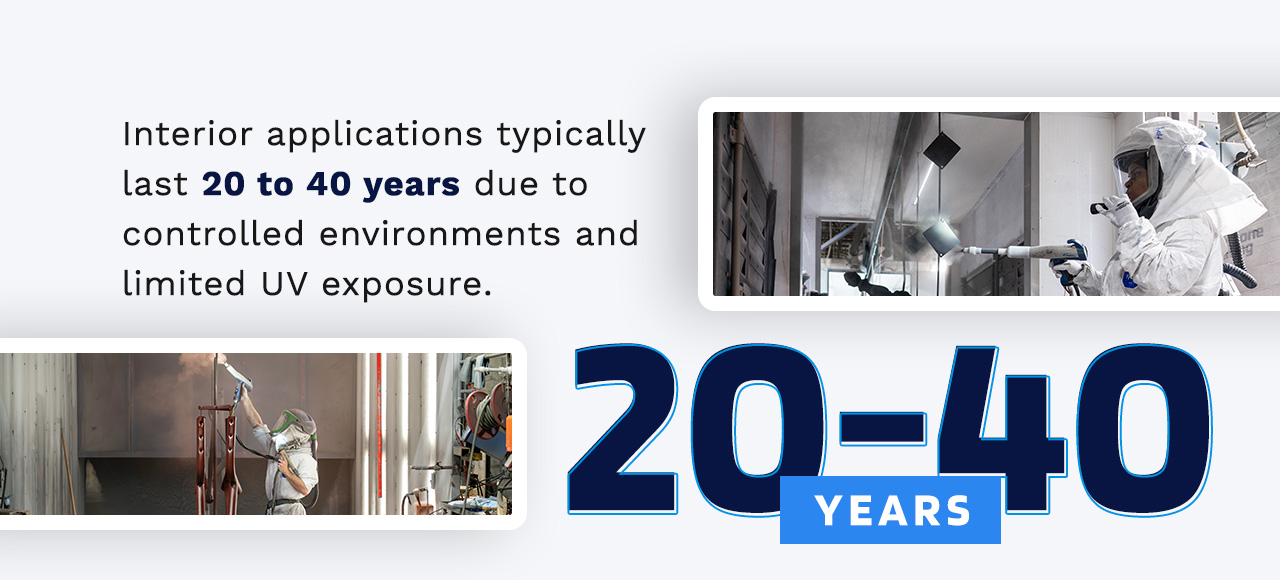
Updated November 25, 2024. Originally published June 15, 2022.
When properly applied and maintained, powder coating can last up to 40 years. Most powder coatings are durable and weather-resistant, providing years of high-traffic use. However, the longevity of powder coating depends on several fundamental factors. Improper application, poor maintenance and using the wrong type could affect performance.
This comprehensive guide examines the factors influencing how long powder coating lasts.
Table of Contents
- Types of Powder Coating
- Environmental Variables
- Powder Coating for Your Next Project From Keystone Koating
Types of Powder Coating
Choosing the right coating type is critical when considering how long powder coating should last. Various industrial and commercial applications can use a few different kinds of powder coating. All types of powder coatings fall under two general categories of polymers:
- Thermoplastic: When heated, these powder coating finishes become liquid and require no chemical bonding. These polymers are great for applications on appliances, metal and automotive parts. Thermoplastics have a low melting point, making them perfect for recycled materials. Examples of thermoplastic coatings include polyester and acrylic.
- Thermoset: Once cured, this powder coating forms chemical bonds and can withstand high temperatures, making it more solid and durable. Examples of thermoset powder coatings include epoxy and polyurethane.

The longevity of powder coatings varies between types and depending on how and where they are applied. While epoxy coatings might last decades in indoor applications, their performance outdoors can be significantly reduced. Understanding these differences helps ensure your powder coating lasts as long as possible.
Some powder coating materials can come in both thermoplastic and thermoset versions. Here are the different types of powder coating finishes you can use on various materials:
1. Epoxy
Epoxies are widely used for their excellent durability and resistance to corrosion and chemicals. Epoxy provides strong adhesion to metals and can be used as a primer under topcoats. This type of coating should be used for indoor applications only, as consistent ultraviolet (UV) exposure can cause fading and deterioration.
2. Polyester
Polyester is a common type of powder coating with a wide range of finishing, gloss and color options, making it a popular choice for appearances. This type of coating can be used in indoor and outdoor applications because it’s resistant to UV weathering, chemicals and corrosion.
Polyester coatings also provide flexibility and wearability to prevent yellowing. However, this powder does have a low cure temperature, so some outdoor applications will only hold up for one to three years.
Other forms of polyester:
- Polyurethanes: Polyurethanes are slightly more elevated than polyester because they have better chemical resistance and hardness. However, they lack flexibility. They can be used in indoor and outdoor applications.
- Super-durable polyesters: These polyesters provide superior powder coating durability and hold their finishing and color for better longevity. Because of their stronger corrosion and humidity resistance, super-durable polyesters can also be used in indoor and outdoor applications.
3. Fluoropolymer
When it comes to outdoor applications, fluoropolymers are a great choice. This type of powder coating has phenomenal weather and chemical resistance and gloss retention properties, making it perfect for architectural applications like doors and windows. Like all powder coatings, fluoropolymers benefit from a liquid or powder primer beneath but provide a one-coat capability in most instances.
4. Urethane
Urethane powders are very similar to the qualities that exist in polyester, but they have better chemical resistance due to different curing agents. This type of powder coating can create a smooth, matte finish that’s perfect for doorknobs and oven knobs where fingerprints won’t be as visible.
Urethane powder meets high standards of longevity and efficiency in interior and exterior applications. However, urethanes are also harder because they’re less flexible, and their general improvements from polyester make them more expensive.
Environmental Variables
Powder coatings can withstand daily use in high-traffic areas for years. Powder-coated items will also see increased durability and resistance to:
- Moisture
- Abrasion
- Peeling
- Chipping
- Impact
Professional preparation and treatment will help extend the life span of your powder coating. Preparation is the most important step in the longevity of your finish, so a clean substrate is essential to ensure proper adherence.
Existing coatings must be stripped down to the bare metal to prevent chipping. However, after consistent exposure, certain environments and factors can adversely affect powder coating and its longevity. It’s important to know how to preserve the condition of your coating through all types of conditions to avoid any issues.
1. Temperature
Temperature variations significantly influence how long powder coating lasts. Most powder-coated items perform optimally in moderate temperatures of 68 to 80 degrees Fahrenheit, or 20 to 26.7 degrees Celcius. Extended exposure to excessive heat and severe cold can accelerate corrosion, potentially reducing the coating’s life span.
If the item is only used seasonally, then where it is stored between the summer and winter determines how long powder coating lasts on metal. It’s a good idea to store metal items indoors during these seasons or when they’re not in use, especially if they’re not well-suited for external applications.
Proper storage will help keep your powder coating looking pristine and performing better longer. High-temperature powder coating for outdoor items like automotive parts, grills and generators is perfect for items with high UV and heat exposure that can’t go indoors. In extremely low temperatures, some powder coatings can see decreased impact resistance.
2. Humidity
Metal objects and surfaces are highly susceptible to corrosion from humidity. High humidity can also affect your powder coating’s appearance and durability. In humid areas, powder coats can absorb and trap moisture before curing, leaving a stained appearance or discoloration. This negative effect occurs because the moisture makes it difficult for proper adherence to happen.

If your metal parts already have a cured coat on the surface, keep them within a range of 50 to 60% humidity, even in storage. Otherwise, you risk corrosion. If your powder coating is in your interior, consider getting a humidifier for better humidity control in the environment and reduce any potential adverse effects on your finish.
Application Technique
The method of application also factors into how long powder coating should last. Proper technique includes thorough surface preparation with complete removal of contaminants and proper profile creation.
The powder application process demands consistent mil thickness and even electrostatic distribution across all surfaces.
Temperature control must be precise during preheating and curing, and environmental conditions within the application booth must be carefully monitored and maintained to prevent contamination and ensure optimal coating adhesion.
Material Considerations
Different substrates call for specific treatments and application techniques. Proper preparation can significantly impact how long powder coating lasts on these materials:
- Steel requires thorough cleaning and often benefits from zinc-rich primers for optimal corrosion protection.
- Aluminum needs specialized pretreatment for optimal adhesion.
- Stainless steel demands unique surface preparation methods.
- Cast iron may require additional preparation due to porosity concerns.
- Brass and copper need specialized pretreatment processes to ensure proper adhesion.
- Nonmetallic surfaces require specific application techniques tailored to their unique properties.
Interior or Exterior Use

Interior applications typically last 20 to 40 years due to controlled environments and limited UV exposure. Exterior applications require specific powder formulations to withstand weather conditions and can achieve 15 to 25 years of service life under ideal conditions and maintenance.
Powder selection and application methods must consider climate considerations and temperature fluctuations. Proper powder selection based on the environment ensures optimal performance and maximum life span.
Maintenance
The longevity of powder coating depends on proper maintenance and care after application. Regular maintenance using appropriate techniques can help ensure your powder coating reaches its maximum potential life span. Proper maintenance includes regular cleaning with pH-neutral cleaners and avoiding abrasive cleaning tools that could damage the finish.
Quarterly inspections can help identify potential issues before they become serious problems. Watch for early signs of cracking or peeling at edges and monitor for chemical exposure damage, particularly in high-wear areas.
To maximize how long powder coating lasts on metal, implement protective measures as part of your maintenance routine. Store items away from extreme temperatures when possible and avoid prolonged exposure to harsh chemicals. Address damage promptly to prevent issues from spreading and compromising the coating’s integrity.
Why Trust Us?
At Keystone Koating, our expertise in determining how long powder coating lasts comes from over 35 years of hands-on experience in the industry. As Pennsylvania’s only PCI 3000-certified powder coater and an AAMA 2604-13 verified facility, we have documented and analyzed coating performance data from thousands of projects across diverse applications and environments.
We regularly monitor powder coating performance in challenging situations, from industrial equipment to architectural components facing years of weather exposure. Our team actively participates in industry research and development, maintaining current knowledge of coating technology advancements. This practical experience and our quality control processes provide us with unique insights into powder coating longevity across various applications and environments.
Powder Coating for Your Next Project From Keystone Koating
Different types of coating are used for various indoor and outdoor purposes that fit your business’s specifications. At Keystone Koating, we offer several kinds of powder coating, including epoxy, polyester and fluoropolymer. We also carry alternative coating options, such as urethane, silicone and hybrids.
With over 30 years of experience in industrial and commercial projects, we can provide quick turnaround times and various high-quality powder coating services. Contact our team today to discuss your next project and see how your business can benefit from our comprehensive coating process. You can also request a personalized quote so we can create a custom package that suits your needs.

